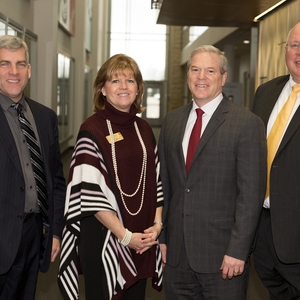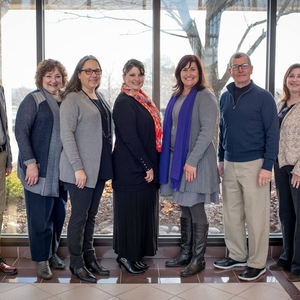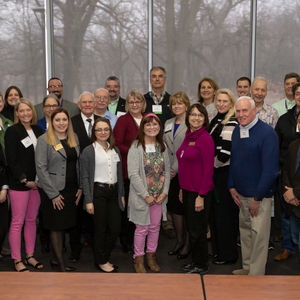Growing Sustainable Communities Together Through Leadership in Higher Education
University of St. Francis, Lewis University, Joliet Junior College, Prairie State College, Governors State University, Moraine Valley Community College
Project Overview
The South Metropolitan Higher Education Consortium (SMHEC) is a unique partnership of 10 higher education institutions in the south metropolitan area of Chicago extending west to Joliet, south to Kankakee and east to the Indiana state-line. Our members are two and four-year, public, private and for-profit degree granting institutions, which provide a distinct opportunity to address key issues with one, stronger voice.
In 2014, SMHEC launched a regional effort to "link" and "leverage" community resources to make the Chicago southland the "greenest region." Communities within SMHEC's boundaries began meeting regularly to share success, identify areas of opportunities and leverage resources. In 2016, our key stakeholders made the decision to create three distinct sub-regions, identified through community college boundaries, to begin and expand sustainability efforts. Through this, the Will County region (Joliet Junior College), Prairie State region (Prairie State College) and Alsip (Moraine Valley Community College) region were developed to connect people, communities and resources to make lasting improvements to each region's economy, ecology and social equity.
In 2018, to demonstrate their collaborative commitment to sustainability and the communities they serve, Joliet Junior College, Lewis University and the University of St. Francis made a formal commitment to link and align existing sustainability efforts to build and leverage relationships between all stakeholders including government, higher education, businesses, non-profit entities and community members, and to establish an infrastructure to support the activities of the network.
As a result of SMHEC's link and leverage efforts, more than 1,000 individuals are subscribed to our mailing list, two large-scale sustainability conferences have been hosted and two formal networks have been launched to expand sustainability efforts in the communities within SMHEC's boundaries.
Background
The South Metropolitan Higher Education Consortium (SMHEC) is a unique partnership of 10 higher education institutions in the south metropolitan area of Chicago extending west to Joliet, south to Kankakee and east to the Indiana state-line. Our members are two and four-year, public, private and for-profit degree granting institutions, which provide a distinct opportunity to address key issues with one, stronger voice.
The mission of the Consortium is for its members to collaborate to enhance education services and programs in the region. Through committees, the Consortium collaborates to leverage resources, enhance programs, and execute projects that address institutional priorities.
The SMHEC Sustainability Committee was established in 2009 by SMHEC’s Presidents’ Council to strengthen its member institutions’ capacities to leverage resources and information particular to sustainability and the application of renewable practices. For 10 years, the group has focused attention on creating resilient campuses, minimizing costs and increasing resources to provide more services to member students and communities.
With this experience and expertise SMHEC began to reach out to its communities to partner and transform the region into the most resilient region in Metropolitan Chicago. A lofty goal, yes, but linking and leveraging existing resources, while identifying new or not yet realized opportunities, helps to make it possible.
In September 2014, SMHEC held its annual sustainability conference and invited targeted community groups to attend; specifically, representatives of municipalities, health care, manufacturing, small business and non-profit organizations. The goal was to gauge interest from the groups to develop a strategy to that would lead to our region become the greenest in the metropolitan Chicago area. The event keynote speaker, Dr. John Albrecht from Gateway Community College, led an engaging discussion on the need for, and benefit of, higher education partnering within local communities to create healthy and livable environs for all of its stakeholders. Also highlighted during the day were SMHEC resources and community needs - the beginning of future conversations about opportunities to leverage resources while addressing community needs.
The event was at Joliet Junior College and had over 130 participants. Just by bringing these groups together, the participants quickly realized that the members and their communities also had resources to be leveraged; not just needs. What more could be achieved by continuing to connect organizations and recognize opportunities to pull together assets? It was clearly a success and spurred tremendous interest from the community members; the evaluations resoundingly expressed the need for and desire to continue events like this.
Following that conference, SMHEC, determined to “link" and "leverage" community resources to make the Chicago southland the "greenest region," offered three additional community events, specifically focusing on the community representatives and community needs.
Following these four events, SMHEC recognized an opportunity to partner with the Metropolitan Mayors Caucus. The Caucus is a membership organization of mayors from Northeastern Illinois’ 273 cities, towns, and villages which provides a forum for elected officials to collaborate on common issues. Much like SMHEC’s efforts, the Caucus was working to align environmental issues, resources, and actions at the local, regional and national levels to guide municipalities to achieve meaningful and measurable environmental sustainability. To do this, they created the Greenest Region Compact (GRC) – A Regional Strategic Plan for Environmental Sustainability; providing a template sustainability plan to achieve greater regional impacts, and connecting financial and technical resources to help municipalities achieve their sustainability goals.
The GRC framework focuses on 10 broad green and sustainable categories. The framework assesses what sustainability-related actions the municipalities, organization and higher education institutions are currently involved in, identifies areas where they can easily improve, and develops an aspirational plan for the more long-term resiliency strategies indicated in the Framework. By leveraging the work of SMHEC and the Caucus, this partnership provides a strong framework for their members to move sustainability forward in a meaningful manner.
In May 2016, our key stakeholders committed to using the GRC framework as a model for our Link and Leverage efforts and simultaneously made the decision to create three distinct sub-regions, identified through community college boundaries, to begin and expand sustainability efforts. Through this, the Prairie State region (Prairie State Community College), Will County region (Joliet Junior College), and Alsip region (Moraine Valley Community College) were developed to connect people, communities and resources to make lasting improvements to each region's economy, ecology and social equity.
Further, in 2018, to demonstrate their collaborative commitment to sustainability and the communities they serve, Joliet Junior College, Lewis University and the University of St. Francis made a formal commitment to link and align existing sustainability efforts to build and leverage relationships between all stakeholders including government, higher education, businesses, non-profit entities and community members, and to establish an infrastructure to support the activities of the network.
SMHECs targeted outreach includes more than 1,000 professionals and regional community members, with the following regional breakdown: Prairie State Region (285), WCRSN (278) and Alsip (68).
As a result of SMHEC's link and leverage efforts, two large-scale sustainability conferences have been hosted, two formal networks have been launched to expand sustainability efforts in the communities within SMHEC's boundaries and a variety of smaller workshops have taken place and numerous communities have adopted the GRC.
Goals
As a program under SMHEC, the various regions involve were established to engage their communities in becoming more sustainable. Principle objectives include:
- Fostering cross-community collaboration
- Providing a vehicle for building upon existing initiatives
- Supporting innovative and effective projects
- Facilitating the sharing of resources
- Promoting successes, build excitement, and catalyze collaboration
Implementation
This program was implemented through SMHEC's sustainability committee and its members. As with all SMHEC committees, members work together to achieve a common goal, in this case, to expand sustainability efforts within the communities our institutions are located.
The executive director of SMHEC, Allessandra Kummelehne (formerly Genny Boesen) facilitates conversation to determine program direction and oversees all aspects of the program. The sustainability professionals at the following institutions (Governors State University, Joliet Junior College, Lewis University, Moraine Valley Community College, Prairie State College and University of St. Francis) identify community concerns, assist in creating event agendas and securing content experts, and promote the event throughout their networks. Together, the committee takes on various roles for each event including event logistics, facilitation needs on the day of, and follow up as necessary.
External committee members were invited to participate in the planning of activities and identification of resources. These committee members represent various units of government, as well as the public and private sectors.
Timeline
The Link and Leverage Initiative was born out of our annual Sustainability Conference in September 2014 when the SMHEC Sustainability Committee realized the need for sharing their expertise throughout their respective communities and connecting those communities to the region. Between September 2014 and May 2015,three forums were hosted where municipal leaders and their constituents were invited to "link" and "leverage" resources.
In May 2015, SMHEC partnered with the Metropolitan Mayors Caucus and hosted a recognition event to celebrate the sustainability successes to date in the various municipalities that fell within SMHECs district boundaries. At this event, the Greenest Region Compact was officially launched (since has been adopted by more than 115 communities in the Chicago-metro area).
In 2016, after reviewing evaluation results indicating the region was too large to "get work done," our key stakeholders made the decision to create three distinct sub-regions, identified through community college boundaries, to begin and expand sustainability efforts. Through this, the Will County region (Joliet Junior College), Prairie State region (Prairie State College) and Alsip (Moraine Valley Community College) region were developed to connect people, communities and resources to make lasting improvements to each region's economy, ecology and social equity.
The three sub-regions spent the next 18 months meeting on their own to determine their region's priorities.
In January 2018, to demonstrate their collaborative commitment to sustainability and the communities they serve, Joliet Junior College, Lewis University and the University of St. Francis made a formal commitment to link and align existing sustainability efforts to build and leverage relationships between all stakeholders including government, higher education, businesses, non-profit entities and community members, and to establish an infrastructure to support the activities of the network.
In October 2018, GreenTown Will County was hosted at Joliet Junior College and the Will County Regional Sustainability Network was launched. Since then, three additional network events have been held, with many more planned.
In February 2019, the Prairie State Region hosted a conference at Prairie State College, "Growing Sustainable Communities Together," where local experts were called upon to address a variety of categories pertaining to the GRC Framework. Quarterly events are planned for the remainder of the year.
Key Dates 2014: SMHEC launches a regional effort to "link" and "leverage" community resources to make the Chicago southland the "greenest region" 2016: SMHEC creates three distinct sub-regions 2018: SMHEC formally launches the Will County Regional Sustainability Network at the GreenTown Will County Conference 2019: SMHEC formally launches the Prairie State Regional Sustainability Network through the Growing Sustainable Communities Together Conference
Financing
SMHEC is a member dues-based organization. Costs associated with meeting space, printing and promotion are absorbed by our operational budget and member institution agreements. Additional costs, particularly related to catering expenses are supported by sponsors and donations.
Results
As a result of this project: * Three community colleges and three universities have been engaged with sustainability as it relates to their communities. * No less than seven communities adopted the Greenest Region Compact * The Will County Region has established a goal to be the first county to have a 100 percent GRC adoption rate (15 of 38 communities have adopted to date) * More than 1000 individuals are subscribed to the regional Link and Leverage mailing list * We have hosted at least a dozen events within the SMHEC region targeting municiapl leaders and community members. * We are connecting to communities spanning three couties in Illinois to create a sustainable future.
Lessons Learned
While we saw overwhelmingly positive results, we had our fair share of challenges. The most apparent one being once external stakeholders were invited to serve on the regional planning committees/steering committees, all three sub-regions faced challenges directly related to the organizational structure of the committee, hierarchy of the committee, ownership of the committee, and roles and responsibilities of the committee.
Now that we are three years into meeting with sub-regions, we are just developing formal committee roles, particularly where finances/sponsorship money is concerned. An additional challenge with committee structure is accountability (particularly for those members that are not affiliated with SMHEC in any other way aside from Link and Leverage. In repeating this process, we would certainly recommend laying out a standard committee structure from the beginning and limit flexibility in that structure (i.e. external members make a great advisory committee if you have an internal process to work on all the details).
Another challenge we faced related to marketing, promotion and targeting the appropriate audience. How many people, and who (i.e. Mayors, Public Works, Community Member, Village Arborist, etc.) are needed in the room for the event to be successful. Who is the appropriate speaker (i.e. are Mayors more likely to listen to their colleagues versus a content area expert) for said audience? How do we engage the correct audience and are we in fact defining the correct audience (i.e. we recently discovered in some cases targeting the Village Trustee is more beneficial than targeting the Mayor). We have not overcome this challenge, however, we have come to understand it is OK to create sub-lists within our regional list for targeted marketing, getting to know individuals and their style is key, and ask your confirmed attendees/speakers for help promoting your event.



